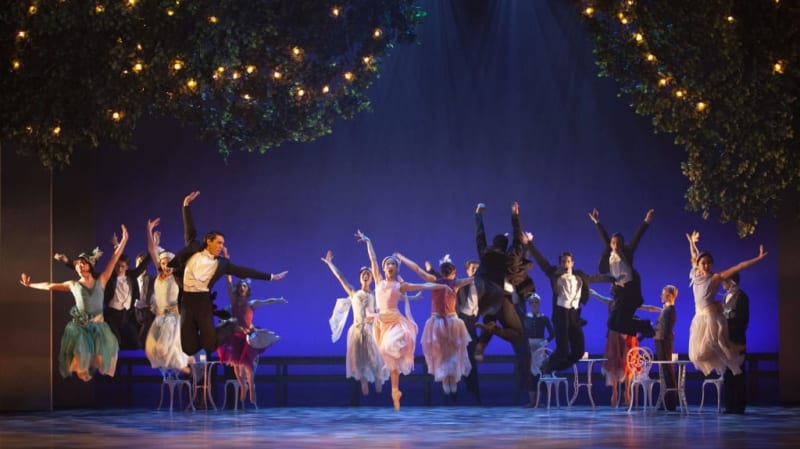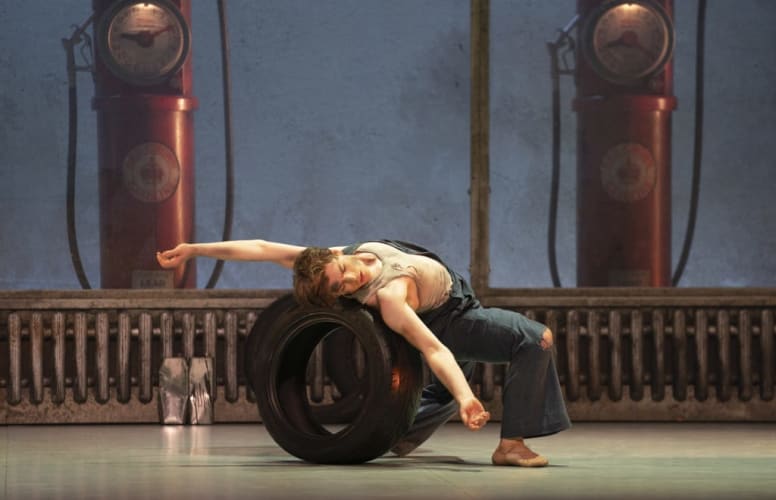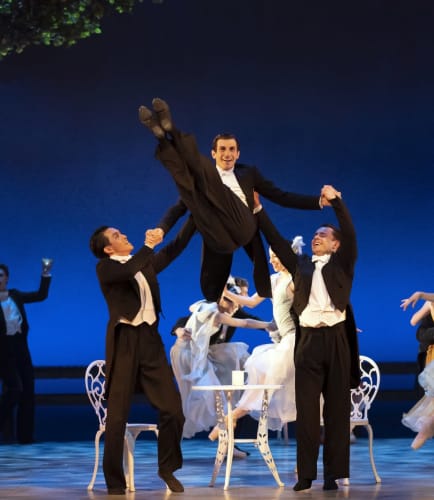Scott Fitzgerald's novel is set in the 'roaring '20s', a period of 'riotous license' in America after the Great War and before the ensuing and all-embracing Depression.
The names and life styles of the very rich—the Guggenheims, Astors, Pulitzers—were well known and many of these millionaires had summer homes on Long Island. This provided Fitzgerald with the topography for his novel about "no-money Jay Gatsby, no-money Nick Carraway and the old-money Buchanans". The couple completely out of this rich league are impoverished garage worker George Wilson and his wife Myrtle who live in the nearby Valley of Ashes.
The ethos of this rich community with its constant partying, heavy drinking, scandals and affairs provides ideal material for the corps de ballet (the party goers) as well as the seven principal characters whose complex interactions and wavering emotional states prove ideal opportunities for creative expression.
The principal female dancer is the lithe and animated Sarah Chun who plays Daisy Buchanan, a constant and enthusiastic partygoer, wife of the severe, dominating Tom Buchanan (Harry Skoupas), pursued throughout by the nouveau riche Gatsby (Jonathan Hanks) who has loved and lost her and holds his extravagant parties in the hope that one day Daisy will turn up.
Skoupas strongly characterises Buchanan’s incipiently brutal, repressive control of his wife and cynical exploitation of his frequently visited mistress, the garage worker's wife, Myrtle, whose irritated rejection of her husband contrasts with the submissive and responsive love she has for Buchanan.
Harris Beattie gives a moving performance as the heartbroken and rejected Wilson, dressed in unmended dungarees, skin stained with black oil, the only character seen in working clothes. His anguish over the relationship with his wife is expressed in a remarkable early dance using a car tyre.
For much of the early action, as in the novel, Gatsby is rarely glimpsed at his parties. The scenario introduces two new characters, the young Gatsby and the young Daisy (Archie Sherman and Julie Nunes), presented as memories. We see their first meeting and begin to understand the nature of Gatsby’s obsession with Daisy, which lasts over many years while he gradually works his way up through a hierarchy of criminal activities to be come a millionaire himself and worthy of Daisy's love.
Fillipo Di Vilio as Nick Carraway, the narrator role in the novel, is an important presence throughout who interacts with all of the main characters. Similarly, Alessandra Bramante’s Jordan Baker, Daisy’s close friend and a famous golfer, becomes a confidante as well as being a convincing member of the dominant group.
As well as the superb performances of the principal dancers, there is much more to enjoy and admire in this sumptuous production. The large corps de ballet representing gangsters, maids and butlers as well as the party guests are well drilled and perfectly co-ordinated in the subservient roles and perform the Charleston and other dances of the period with verve and enthusiasm.
The music is attributed to Richard Rodney Bennett and the programme includes a long list of music from films and other sources which have been integrated into the orchestral accompaniment. The Northern Ballet Sinfonia under Music Director Jonathan Lo is a large orchestra with broad capability. There were occasions when the jazz idiom of the period is given full rein and others when timpani, percussion and harp are used to create tension or mood.
The set design by Jerome Kaplan uses the height and breadth of the stage to create wide vistas, so it is believable that Gatsby is standing at the edge of his property, staring obsessively across the watery divide that separates him from his longed-for love. The internal scenes are equally full of invention. The distorting glass window frames in huge doors provide an appropriate metaphor in a ballet in which what is seen is not necessarily real or true.
It is good that this excellent production with its stunning setting and costumes has been revived. I would urge readers to catch it on its current tour and suggest that for those who haven’t seen it before, it would be helpful to read Fitzgerald’s novel since so much detail from that is included in the action.


